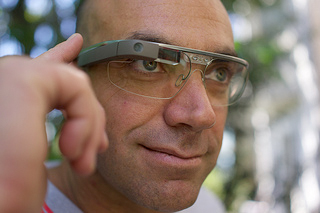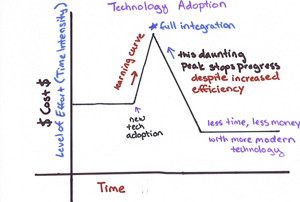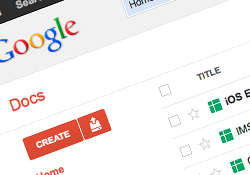Matt Britland focuses on the impending force of cloud computing as the future dominant mover and shaker in schools and colleges which is set to underpin what we now call 'social learning'.

A couple of weeks ago I was asked what I thought the future of technology in education was.
It is a really interesting question and one that I am required to think about all the time. By its very nature, technology changes at a fast pace and making it accessible to pupils, teachers and other stakeholders is an ongoing challenge.
So what is the future? Is it the iPad?
No, I don't think it is. For me, the future is not about one specific device. Don't get me wrong, I love the iPad. In fact, I have just finished a trial to see if using them really does support teaching and learning – and they have proved effective. I've written about the trial in more detail on my blog.
Photo credit: johnnyryan1

Here is the second article in our series on maximising the use of visualisers across different curriculum areas. We'll be looking at literacy and English classes from key stages one to four.
Use visualisers at key stages one and two to help in building a foundation of basic literacy concepts:

Would you really replace your specs with a computer? Or wear a camera on your head?
It can only be a matter of time (and maybe not too much money) before Google Glass, or 'Glasses' as I call them, glide gracefully through the classroom doors and onto the heads of every boy, girl and teacher who cannot escape the futuristic amazement of this augmented reality phenomenon. Well, so they say.
If you haven't heard of Google's latest innovation - in essence a pair of fake glasses with the functionality of a Chromebook displayed to you in its right lens - then I suggest you check it out. It is a glimpse into the future.

Every day we come across a multitude of acronyms which can be confusing and, at times, impossible to understand. Do you know your LAN from your WAN or your MDM from your CMS?
Acronyms are familiar only to individuals in their specific field and can often mean different things in different professions. They are widely used in the workplace and increasingly in the technological world. Keeping up with the fast pace of technology can be an arduous task, so I have attempted to explain the meaning of some of the more common acronyms used on a daily basis.

What are we educating our children for?
"Just in the past couple years, we've seen digital tools display skills and abilities that … eat deeply into what we human beings do for a living.” (Andrew McAfee)
"Are droids taking our jobs?" is a very powerful presentation by Andrew McAfee which looks at the great changes in civilisation. One change trumps them all: the technological advances that led to the industrial revolution. For the first time, humans were no longer restricted by the power of muscles, with machines replacing horses, and manufacturing on a mass scale replacing skilled craftspeople.
We are now experiencing another great revolution: the digital revolution that, if anything, will have a more profound effect on the world. We are seeing developments like the cognitive IBM computer Watson able to make decisions, and personal assistants like Apple’s Siri that can act as an interface between humans and machines. Linking these two would give us something capable of making better decisions than the vast majority of humans. This is not the future, this is the capability now; if Moore's Law is followed, in six years’ time, these are likely to be sixteen times as powerful. So we will no longer be restricted by the limitations of human brain power. This begs the question: what is the role of human beings going to be in the future and, more importantly, how will we equip our young people with the skills to cope with this new world where the only certainty is uncertainty?

In my last post, we talked about “digital citizens”, the modern student who lives in two worlds. One he can touch with his hands, the other only with his mind. It’s this latter one that has revolutionised education, provided opportunities for students to talk to experts on astronomy, walk through the ancient ruins of Stonehenge, and dissect a frog without touching a scalpel. This world is scintillating, but challenging, demanding students to be risk-takers and inquirers.
That last inquiry has changed the K-12 classroom from what many experienced just a decade ago, for students cannot be inquirers without being risk-takers. They take responsibility for their own learning by following practical strategies for uncovering information despite the billions (literally) of places to look. Consider this: If you Google 'space', you get over 4 billion hits. That much information is worthless. Digital citizens develop practical strategies for refining this list to a specific need.

Isn't it curious that all of you and and all of your students use the internet daily but none of you exploit its potential for teaching, learning and creativity? Isn't it curious that schools force their students to inhabit this alternative reality for six or seven hours every day where the internet doesn't exist?
Earlier this week I led a seminar for PGCE students at Nottingham University on the use of the internet and its potential for encouraging pupils’ creativity. To start, I asked those present to put their hands up if they used the internet daily. All hands went up. I then asked them to keep their hands up if their pupils used the internet on a daily basis. After a moment’s thought, all hands stayed up.
However, when I asked the PGCE students – who had all finished their first teaching placement – to keep their hands up if they planned or been encouraged to plan lessons, sequences of lessons or homework that required the use of the internet, all hands went down. Isn’t it curious, I asked them, that all of you and and all of your students use the internet daily but none of you exploit its potential for teaching, learning and creativity? Isn’t it curious that schools force their students to inhabit this alternative reality for six or seven hours every day where the internet doesn’t exist?

With the advances in technology hitting our classrooms on such a regular basis, we sometimes forget that the old ways are sometimes the best ways. You can have all the technology in the world, but sometimes being creative with what you've got can be a lot more powerful.
I stumbled across a fantastically creative, but amazingly simple, website a few months ago called Dear Photograph. Although the website is not intended to be an educational tool, with a bit of creative thinking, you'll find that the idea can be used to promote learning across a range of subjects.

I spent some time in a local school this week talking to some members of staff about implementing educational technology. It made me realise that I haven’t talked nearly enough here about how to do that successfully. It’s simultaneously straightforward and painfully difficult.
Let me explain.
Technically, pretty much anything is possible. Short of thought-transfer and teleporting to the moon, we live in a world with endless possibilities on the technical front. Whatever it is you want to do is probably possible.
Sucessfully implementing technology in your organisation is therefore not a technology issue. Yes, it’s important to get right. But no, if you just focus on that your technology implementation will not work.
Here’s some advice for those seeking to introduce a new technology into their organisation.
Photo credit: Veribatim

Let’s face it, there is little doubt that tomorrow is going to be electronic, and that's an exciting thought… or at least it should be! For this very reason, many educators are striving to embrace technology. Their students are growing up in an ever-changing technological world and, as educators, we need to keep ahead, be innovative, and integrate technology effectively and securely into the curriculum. Technology helps to motivate our students, keep them engaged, aids communication and creativity, and helps them to develop the skills to work collaboratively. Whilst the less enthusiastic are yet to fully embrace technology, it is time to recognise that technology has become more than registration, planning, e-mailing or other administrative tasks.
Trying to change the mind-set of teachers, parents and governors, who are yet to come on-board, may well be seen as an arduous task but they do need to start thinking differently. The real challenge is that young people think differently and, quite simply, the educational and technological worlds are coming together and accommodating their needs whether we like it or not. Young people need to be equipped with both technological and social skills to take them into the future and ready for the world of work.

A community-driven platform for showcasing the latest innovations and voices in schools
Pioneer House
North Road
Ellesmere Port
CH65 1AD
United Kingdom